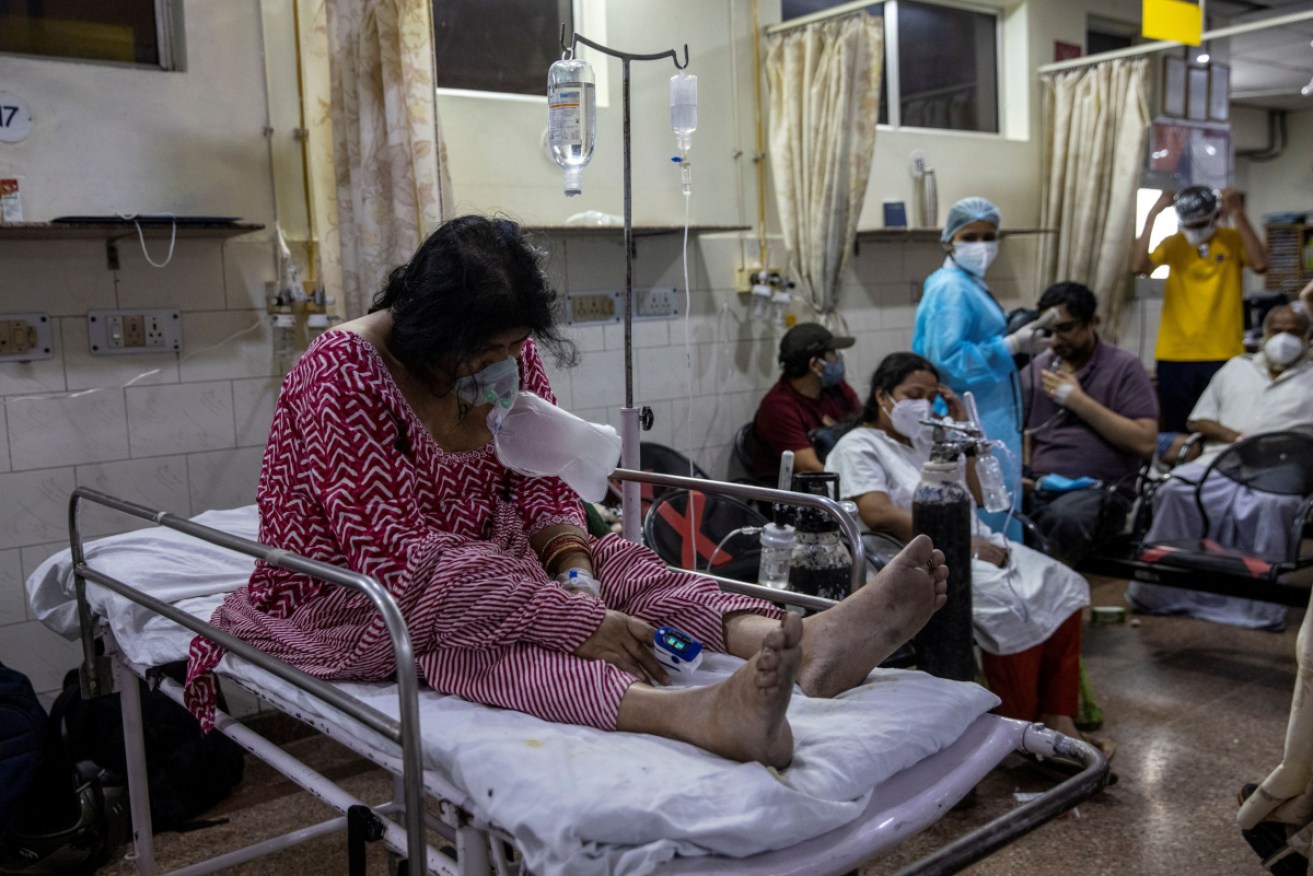In the midst of the COVID pandemic, India is battling a surge of ‘black fungus’

India has recorded over 22 million confirmed cases of COVID-19 to date. Photo: AAP
As India grapples with a deadly second wave of COVID-19, a new threat is emerging: a rare infection called mucormycosis, or the “black fungus”.
Even prior to the pandemic, the rare fungal infection disproportionately affected Indian patients, with the prevalence of the infection estimated to be about 70 times higher in India than the rest of the world.
But University of Queensland professor of medicine Paul Griffin said COVID-19 “tipped the balance” in the favour of the disease.
“With the germ there in the background, it’s inevitable in a lot of ways we will see more cases [of mucormycosis] reported in India,” he said.
What is mucormycosis?
Mucormycosis is a fungal infection caused by a group of moulds called mucormycetes, found in soil and in decaying vegetation.
The infection affects the sinuses, brain, lungs, skin and kidneys, and symptoms depends on where in the body the fungi is growing.
Most commonly, patients present with a blocked nose and sinus pain, but they often also get a headache and fever.
People can lose their sight if the eye socket becomes infected, and the infection can spread to the brain, causing seizures, coma and comprehension difficulties.
With patients who get the infection on their skin, mucormycosis can look like blisters or ulcers, and the skin may turn black.
Julie Djordjevic, head of the fungal pathogenesis group at the Westmead Institute for Medical Research, described the fungi as “nature’s decayer”.
“Their job is to break down organic matter; if they weren’t there, there wouldn’t be a world as we know it,” she said.
“And they’re very effective at replicating themselves.
“They make spores which are very airborne and they can produce billions of them.”

Mucormycetes are a type of mould found in soil and in decaying vegetation. Photo: Getty/BSIP/Universal Images Group
People can get sick if they breathe in or eat some types of spores from the environment, but they can also enter the body through a cut or broken skin.
Professor Griffin said the specific germs that caused mucormycosis were more prevalent in countries such as India because of local environmental conditions (such as temperature and humidity).
“We don’t see infections from them very often because it does require a very susceptible host for them to establish an actual infection,” he said.
“Usually the kind of patients we would see [the infections] in are patients who have had transplants or that sort of thing, where they are on very strong medication to turn their immune system down.”
Dr Djordjevic said those with a compromised immune system (such as people recovering from COVID-19) were more at risk of the fungal infection, as were people with diabetes because of their high sugar levels.
“Fungi, when they infect you, [sugar is] what they love eating,” she said.

India’s COVID-19 cases have surged between 350,000 and 400,000 on a daily basis for the past two weeks. Photo: EPA
According to the US Centre for Disease Control and Prevention, the overall mortality rate of mucormycosis is about 50 per cent, although outcomes are better with early diagnosis and treatment.
“It is often associated with bad outcomes, but a lot of that reflects the host … we often see it in very sick patients,” Professor Griffin said.
Mucormycosis isn’t contagious, and can’t be spread between people or between people and animals.
So how has COVID-19 made things worse?
Indian health authorities have been reporting more cases of mucormycosis in patients recovering from COVID-19 for a few reasons.
People who have been unwell with COVID-19 and are still recovering have a compromised immune system, which means they’re more at risk because their body can’t fight off the infection.
And those who were hospitalised with severe COVID-19 disease were likely to be prescribed a steroid called dexamethasone to reduce infection.
This drug works to reduce inflammation in the lungs and to dampen the body’s immune response (to stop it attacking the body’s healthy cells).
“You’re suppressing the immune response, so we don’t die from that,” Dr Djordjevic said.
“But at the same time you’re creating another problem in that all these other opportunistic pathogens, there’s no immune surveillance to keep them under control.”
Professor Griffin said the steroid was still an important treatment option for COVID-19 disease.
“We do still need to use [dexamethasone], it’s been proven to work,” he said.
“We’ve tipped the balance in the favour of [mucormycosis] by adding a lot more susceptible hosts into the equation.”
Professor Griffin said because of the pandemic, more people were engaging in the healthcare system, which also increased the risk of infection.
Will we see more black fungus in other countries?
According to the experts we spoke to, it’s not likely.
“I’d hoped to say it’s unique [to India],” Professor Griffin said.
“The number of cases there is extraordinary at the moment.”
According to the World Health Organization, India has nearly 22.3 million confirmed cases of COVID-19 to date, with 403,738 in the past 24 hours.
But, Professor Griffin said a lot of other countries don’t have the same environmental conditions as India, which have helped mucormycosis thrive there.
And India also has a high rate of undiagnosed diabetes, which puts many at risk of infection.
“I wouldn’t necessarily think we’ll see that in a number of other parts of the world, but it’s a possibility if we don’t stay on top of COVID, that’s for sure,” he said.
Dr Djordjevic agreed.
“Provided we can get COVID under control in Australia, I don’t think it’s going to be such a problem here,” she said.
‘Easy to diagnose’ but treatment is expensive
Professor Griffin said in countries such as Australia, doctors would be able to recognise and diagnose the infection early.
And now that it’s been identified as an issue, Professor Griffin said Indian doctors would likely be on the lookout for symptoms.
“It’s easy to diagnose with invasive tests,” he said.
“But not all countries have access to the antifungal treatments needed to treat it.”
-ABC








